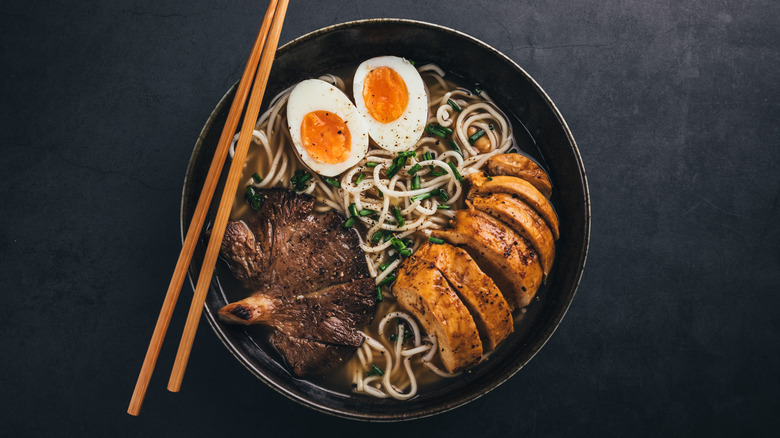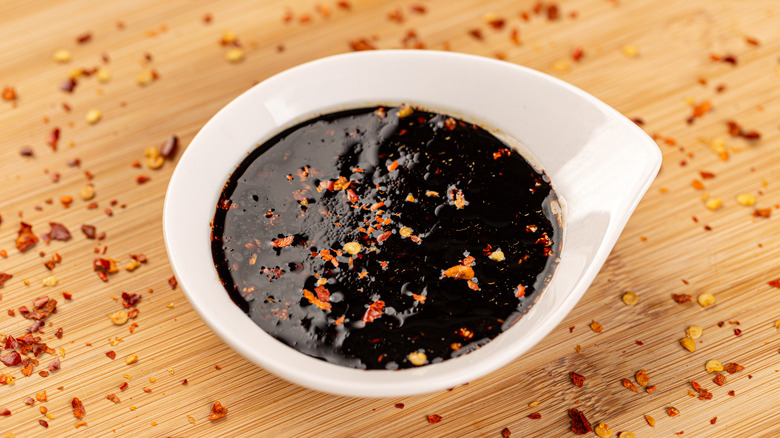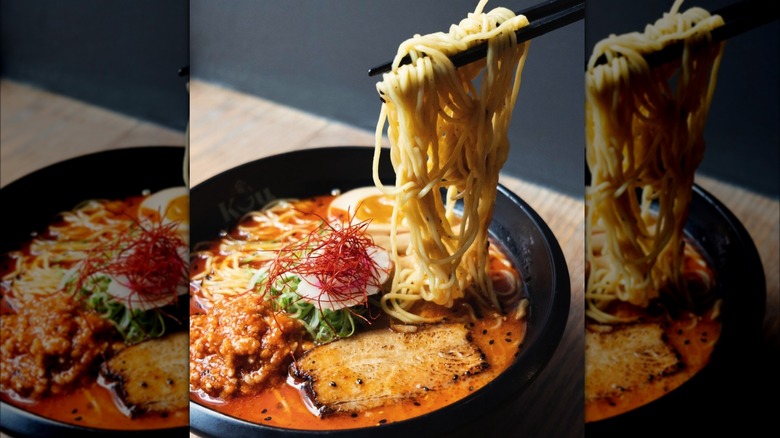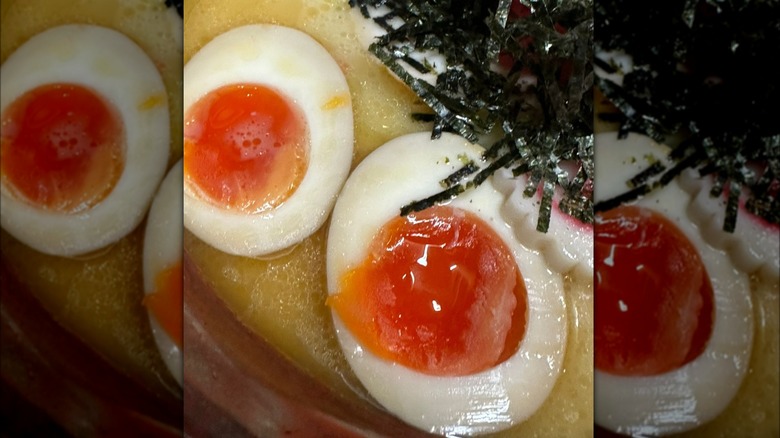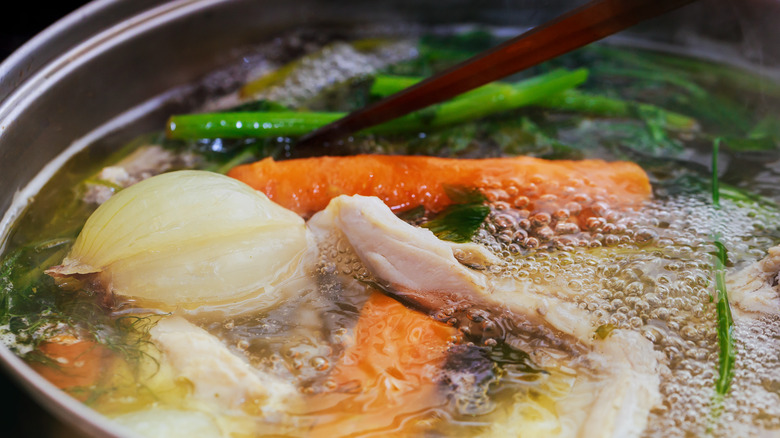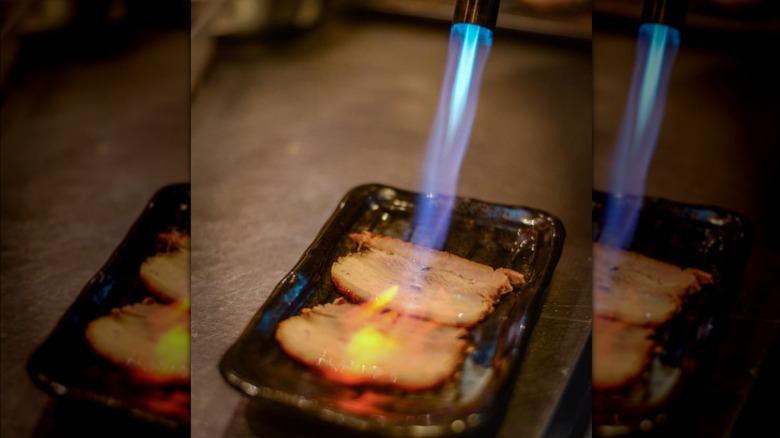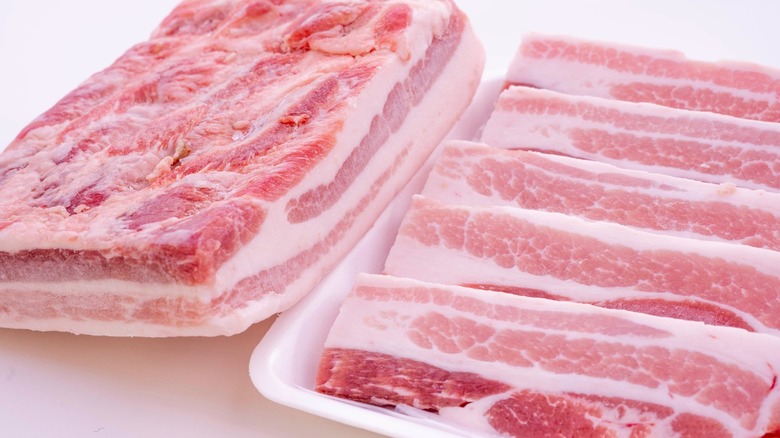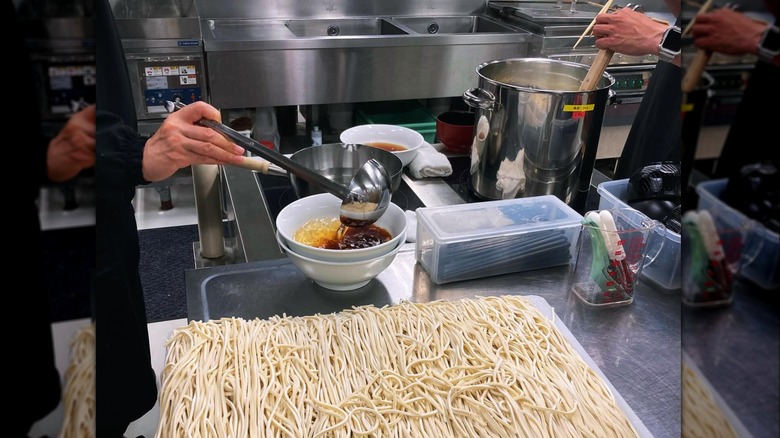Why Ramen Tastes Better At A Restaurant Vs At Home
Ramen is one of my all-time favorite foods, and after living in East Asia for years, I can say that I've been fortunate enough to have eaten at some of the best ramen restaurants in the world. Whether I was in South Korea roaming the streets of Seoul and Busan or on vacation in Osaka, Japan, I was constantly on the prowl for a steaming bowl of ramen and able to directly observe chefs in action. Succulent pork belly that gently melts in your mouth, noodles bathed in broth teeming with luscious umami, a jammy soft-boiled egg with a perfect yolk — for me, this is the stuff that dreams are made of. Naturally, as a lover of ramen with professional cooking experience, I've made a few attempts at whipping up a batch in my own kitchen. As it turns out, replicating top-tier ramen at home happens to be challenging and time-consuming.
On the surface, ramen seems pretty simple: meat, egg, noodles, broth. Maybe a pinch of green onions, a few strips of nori, or some bok choy. How difficult could that possibly be? Once you try cooking it for yourself, you'll humbly realize that preparing an exceptional bowl of ramen is no easy feat. There is a mastery of knowledge, skills, equipment, and ingredients that must be possessed in order to deliver the heights of flavor that chefs at restaurants can achieve. Read on to learn more about why ramen tastes better at restaurants and homemade versions often fall flat.
There's an elusive secret ingredient: tare
Tare (pronounced "tah-reh) is a Japanese word that means glaze or sauce. In Japanese cuisine, tare plays a major role as a flavoring agent in a variety of ways. In its most basic form, tare may essentially be little more than soy sauce or a teriyaki recipe; it often incorporates a blend ingredients such as mirin (sweet rice wine), sake, and a sweetener of some kind like honey or brown sugar. It is often used as a dipping sauce for yakitori (skewered grilled chicken) but it's also a key ingredient in many ramen recipes.
The thing about tare is that chef's often have their own unique recipes that they've gradually tweaked and developed for a long time. This means that when you have a bowl of ramen that blows you away at a restaurant, there's a very good chance that tare played a big role in how it tasted. The odds of the chef sharing his special recipe with diners or you totally nailing it down at home are slim to none. Sure, you might be able to make a simple and respectable tare at home that's still yummy, but if you don't have a lot of experience cooking ramen, knocking it out of the park with the same caliber of complexity that restaurants do is unlikely.
Restaurants make ramen noodles from scratch
Be honest: How often do you make noodles from scratch? For most of us who aren't professional ramen chefs or pasta makers, the answer to that question is almost never. If you take the time to make ramen at home, I'm willing to bet that most of your time and energy will be spent on making a broth that you're happy with and preparing the meat to your liking. Going the extra mile to also make the noodles probably isn't on the agenda. You're likely going to rely on a package of dried noodles that you copped from a cheap pack of instant ramen. And I certainly can't blame you for that. Living in such a busy world, convenience often reigns supreme.
But let's not pretend that those pre-made noodles at the grocery store can compete with noodles made from scratch. They'll get the job done, but they can't really hold a candle to the buttery taste and exquisite texture of fresh ramen noodles. At good ramen restaurants, the noodles are prepared in-house — which is a project that most of us probably aren't going to take on to make a bowl of soup at home.
The egg is cooked and marinated perfectly
Part of the joy in eating ramen is the egg — and there's something special about the eggs featured in a bowl of ramen. Japanese soft-boiled eggs have an amazingly silky texture that requires perfect timing. If the egg is boiled too long, it will be firm and chalky. If the egg is undercooked, the yolk will be too thin. What we're looking for is for the yolk to have a jammy, custard-like consistency — which can be surprisingly difficult to pull off for home cooks who haven't nailed down the proper method to consistently produce deliciously flawless results.
Beyond perfecting the egg's texture, the best ramen eggs are also marinated — this is another area where a chef's special tare comes into play. The outer layer of the eggs soak up the flavor of sweetened soy sauce to create a complex flavor that's truly mouthwatering. For optimal results, ramen eggs are often marinated for a day. That means if you want to make a truly awesome bowl of ramen at home, you'll need to prepare your eggs ahead of time by par-boiling them and letting them marinate in the fridge the day before you want to serve your ramen. Making ramen eggs requires making tare and a level of timing and preparation that many home cooks probably haven't quite mastered. However, if you do want to make your own ramen eggs, be sure to check out Gordon Ramsay's trick to making perfectly yolky soft-boiled eggs.
Restaurants have the time and resources to make fresh, rich broth
Fresh broth is crucial to delicious ramen. But how do you make good ramen broth? How do you know when you should be using stock versus broth? The answer depends on the type of ramen that you want to make, but in general, the base used for ramen requires a long simmer with ingredients that contain collagen. Collagen is a protein that's found in bones and connective tissue. If you've ever simmered chunks of bone-in chicken to make soup, stored it in the fridge, and noticed that gelatinous jiggle that forms after being cooled — that's from collagen. It gives soup a velvety depth that makes it extra rich and delicious.
One of my favorite ramen shops in South Korea was only a block from my apartment, and when I'd saddle up in my usual seat, there was always an enormous cauldron boiling. At first glance, it was hard to see through the steam above the simmering bubbles, but when I looked closely, I'd notice a bunch of chicken feet churning around. No matter what time of day I visited, the cauldron was always simmering. This is a good example of what distinguishes restaurant ramen from homemade ramen. Ramen restaurants invest serious time simmering broth, whereas home cooks generally aren't willing (or able) to dedicate the day to keeping an eye on a stock pot. Cooks at home tend to use pre-made broth, which isn't as tasty as the broth made in-house at ramen restaurants.
Restaurants use a blowtorch to add texture and depth of flavor
My favorite type of ramen, tonkotsu, has a broth made of pork bones and features a couple slices of braised pork belly ("chashu" in Japanese). Because the pork belly is braised, the meat is ultra tender. To add textural contrast to the pork, chefs often use a kitchen blowtorch to sear the edges of the pork belly. The concentrated flames of the blowtorch allow chefs to be extremely precise in where the heat is directed. The intense heat gives the pork belly a light char that gives the meat a lovely texture and it also infuses a tasty smokiness.
While more serious cooks may have a culinary blow-torch on hand in the kitchen, I think it's safe to assume that's not the case for most people. Instead of using a blowtorch to char pork belly for their ramen, many home cooks will most likely broil it in the oven. And while this can still certainly produce delicious results, it doesn't impart the same flavor as the direct flame or the accuracy of a blowtorch. If you've noticed the meat in ramen at restaurants has a superior texture and flavor, this may have something to do with it. Whether you're trying to make ramen at home or using the rotation technique to properly torch crème brûlée, a culinary blowtorch can definitely come in handy.
Restaurants have access to excellent ingredients
Speaking of pork belly, depending on the area that you live in, it can be difficult to find a nice cut. And if a local grocery store does happen to sell it, it often comes packaged in pre-cut slices. On the surface, this may seem convenient, but it can present a potential issue if you want more control with the thickness of your pork belly. Finding a whole pork belly for sale at the grocery store might be challenging.
Most good ramen restaurants have direct connections with butchers and distributors, so it's much easier for them to score a whole pork belly and other choice cuts of meat. A wider access to higher-quality ingredients gives restaurants a major advantage over consumers that often translates to better food. Whether it's getting choice cuts of pork belly or purchasing specialty ingredients to develop mind blowing tare and soup stock, the scales definitely tip in favor of restaurants on this one.
Restaurants benefit from expert timing
Timing is often crucial to success and that's especially true in the kitchen. Restaurants tend to have a lot of labor at their fingertips, which allows them to tackle multiple tasks all at once. When it comes to ramen assembly, having multiple chefs working together creates a situation that enables them to layer everything in a way that maximizes each ingredient. While one chef gets the broth ready, another can torch the pork belly, while another chef can cook the noodles. At the last minute, the team brings it all together so that everything is as fresh and hot as possible. This is hard for a single cook to accomplish at home. Especially if your kitchen is cluttered and unorganized. Seriously, take the time to reorganize your kitchen every few months.
A home cook may add the noodles to the broth too quickly while still waiting for the pork belly to finish, resulting in mushy noodles. There are a lot of different ingredients to juggle, and each one needs to be handled the right way if you're aiming for the same level of excellence as a restaurant. The bottom line is that delivering the freshest bowl of ramen possible is much easier to do at a restaurant when there's a whole team in the kitchen working in unison. Let this be a reminder that while accomplishing certain tasks alone can be gratifying, some jobs are best carried out as a team — like cooking up a killer bowl of ramen.
